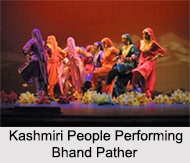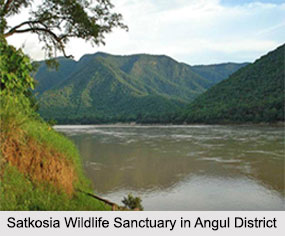 Kashmiri theatre forms an integral part of Kashmiri culture. Having a recorded history that dates back centuries, Kashmiri theatre is an art form, which is rich in content. However, Kashmiri theatre has had a rather chequered development, and even though it started off with great pomp and splendour, it witnessed a significant setback in the later stages of its development. Currently, much effort is being made for the revival of Kashmiri theatre.
Kashmiri theatre forms an integral part of Kashmiri culture. Having a recorded history that dates back centuries, Kashmiri theatre is an art form, which is rich in content. However, Kashmiri theatre has had a rather chequered development, and even though it started off with great pomp and splendour, it witnessed a significant setback in the later stages of its development. Currently, much effort is being made for the revival of Kashmiri theatre.
History of Kashmiri Theatre
Kashmiri theatre flourished under royal patronage in the ancient period of Kashmiri history. The ancient golden age of drama in Kashmir lasted 1500 years, commencing from the Christian era right up till the 15th century. Following this flowering of Kashmiri theatre, the medieval period saw a certain stagnation setting in the field of dramatics. Following the 12th century, there were a number of emergent issues that Kashmir had to deal with- invasions, attacks, floods, famines, raids, fires and epidemics. This left little or no time to be devoted to all forms of arts and literature, and resulted in the loss of books, manuscripts and plays. It was during this time that folk theatre continued to survive and made its presence felt in the form of the Bhand Pather. The modern era, with the spread of awareness and education saw a revival of the performing arts and consequently of Kashmiri theatre. Sustained efforts are still being made to develop the field of Kashmiri theatre.
Revival of Kashmiri Theatre
Efforts towards the revival of Kashmiri theatre have been seen since the early part of the 20th century. The earliest sign of a revival was seen in the establishment of theatre companies such as Maharaja Drama Company, Kashmir Theatres Ltd and Amateur Drama Company etc. Following the establishment of such drama companies, Kashmiri theatre went through a gradual process of development, encompassing various phases along its way. The era of the Dharmic theatre was when a number of socio-political and religious organisations started putting up plays of a religious and mythological nature, such as the "Satich Kahwaet" (The Touch-Stone of Truth) written by Nand Lal Koul in 1929.
 It was late in 1938 when the first full-length modern Kashmiri play titled "Grees Sund Ghare" (Home of the Farmer) was written by Professor Mohiuddin Hajni about the plight of Kashmiri farmers. Political unrest and democratic struggle saw the need for a serious expression of the people`s aspirations. The subsequent era of progressive theatre saw many revolutionary and historical events taking place. The nationally emancipated indigenous theatre movement of Kashmir turned into a sponsored propaganda theatre movement in 1953 when the "Kashmir Cultural Front" was dissolved and a new cultural outfit by the name of "Kashmir Cultural Congress" was formed to propagate, propel and prosper the new political ideology of socialism, secularism and democracy as put forward on national level. When the concept of the `five R`s` was introduced in Kashmiri theatre, following the construction of the Tagore Hall, the Renaissance period of Kashmiri literature is said to have emerged.
It was late in 1938 when the first full-length modern Kashmiri play titled "Grees Sund Ghare" (Home of the Farmer) was written by Professor Mohiuddin Hajni about the plight of Kashmiri farmers. Political unrest and democratic struggle saw the need for a serious expression of the people`s aspirations. The subsequent era of progressive theatre saw many revolutionary and historical events taking place. The nationally emancipated indigenous theatre movement of Kashmir turned into a sponsored propaganda theatre movement in 1953 when the "Kashmir Cultural Front" was dissolved and a new cultural outfit by the name of "Kashmir Cultural Congress" was formed to propagate, propel and prosper the new political ideology of socialism, secularism and democracy as put forward on national level. When the concept of the `five R`s` was introduced in Kashmiri theatre, following the construction of the Tagore Hall, the Renaissance period of Kashmiri literature is said to have emerged.
Kashmiri theatre was then for the first time introduced to the modern techniques of the proscenium theatre in the concept of lighting, designing and Acting. Following significant development in this era came in the revolution phase which saw new experiments being made in style and form of play-writing and presentation. The Decade of 1980-90 could be considered as the Golden Period of contemporary Kashmiri Theatre.
It was in 1980 when Jammu and Kashmir Academy of Art Culture and Languages, started holding District Drama Festivals in all districts of J&K. Apart from this, a number of other institutes such as the National School of Drama, and Sangeet Natak Academy played a major role in promoting and strengthening Kashmiri theatre. The period from 1991 to 2000 again saw a downturn in theatrical works as Kashmir was plagued by militancy during this time. After a gap of almost twelve years, the J&K Academy of Art Culture & Languages organized a theatre festival of six plays in 2002 at Tagore Hall Srinagar which again encouraged the theatre activists to rejuvenate the theatre movement of Kashmir.
Popular Kashmiri Theatre Forms
Bhand Pather, Achi Lamo, Mane-Pa, Ras and Bhagat are the popular forms of Kashmiri Theatre. Bhand Pather is one of the most famous theatre forms of Kashmir. Pather means drama in Kashmiri language and Bhand means performer or actor. This form does not have any particular theme; it can be anything depending on the situation and available material. Achi Lamo form depicts the Buddhist Jatik Katha; normally it is a Tibetan form which has been hugely accepted by the Ladakhi people. Mane-Pa is written in narration and dialogue and is enacted by the professional Mane-Pa families in Ladakh. Ras and Bhagat performed in Jammu region have some religious significance. This form shows the scenes of Indian epics like Ramayana and Mahabharata.




















